关于学术论文英文摘要写作技巧
学术论文英文摘要的写作方法——中外学术论文的英文摘要对比分析

学术论文英文摘要的写作方法——中外学术论文的英文摘要对比分析摘要是学术论文中的重要组成部分,它是论文的简洁概括,能够让读者快速了解论文的主要内容和研究成果。
在撰写学术论文的英文摘要时,需要注意一些方法和技巧。
本文将进行中外学术论文的英文摘要对比分析,以帮助读者更好地掌握学术论文英文摘要的写作方法。
首先,中外学术论文的英文摘要在长度上有所不同。
一般来说,中文摘要的字数较多,可以达到300字以上,而英文摘要一般在150-250字之间。
这是因为中文更为详细和丰富,而英文则更加简洁和精炼。
其次,中外学术论文的英文摘要的语言风格也存在差异。
中文摘要多使用复杂的句式和较为冗长的表达方式,这与中文的语法结构和修辞手法有关。
而英文摘要则更倾向于使用简洁明了的句式和简练的词汇,以便更容易被非英语背景的读者理解。
此外,在摘要的结构组织上,中外学术论文也有所不同。
中文摘要一般包括研究背景、研究目的、研究方法、研究成果和结论等方面的内容。
而英文摘要则通常包括背景介绍、研究目的、方法、结果和结论这几个部分。
英文摘要的组织结构更加简洁明了,突出论文的研究重点和关键结果。
最后,中外学术论文的英文摘要在语言表达上也存在差异。
中文摘要更注重描述研究的细节和具体过程,而英文摘要则更注重突出研究的主要发现和结论。
在英文摘要中,应该使用简洁明了的句式和准确的词汇,避免使用复杂的从句和修辞手法,以便让读者快速理解和消化论文的主要内容。
综上所述,学术论文英文摘要的写作方法在中外学术论文中存在一定的差异。
英文摘要要注意长度、语言风格、结构组织和语言表达等方面的技巧,以便更好地呈现论文的主要内容和研究成果。
通过对比分析中外学术论文的英文摘要可以帮助研究者更好地掌握学术论文英文摘要的写作方法。
论文中英文摘要写作技巧

论文中英文摘要写作技巧写论文的时候需要写摘要,那么论文中英文摘要写什么?下面是应届毕业生小编为大家收集的关于论文中英文摘要写作技巧,欢迎大家阅读!1.摘要的作用摘要也就是内容提要,是论文中不可缺少的一部分,。
论文摘要是一篇具有独立性的短文,有其特别的地方。
它是建立在对论文进行总结的基础之上,用简单、明确、易懂、精辟的语言对全文内容加以概括,留主干去枝叶,提取论文的主要信息。
作者的观点、论文的主要内容、研究成果、独到的见解,这些都应该在摘要中体现出来。
好的摘要便于索引与查找,易于收录到大型资料库中并为他人提供信息。
因此摘要在资料交流方面承担着至关重要的作用。
2.书写摘要的基本规范和原则(1)论文摘要分为中文摘要和外文(一般为英文)摘要。
摘要在篇幅方面的限定,不同的学校和机构有不同的要求,通常中文摘要不超过300字,英文摘要不超过250个实词,中英文摘要应一致。
毕业论文摘要可适当增加篇幅。
(2)多向指导教师请教,并根据提供的意见及时修改,以期达到更高水平。
(3)摘要是完整的短文,具有独立性,可以单独使用。
即使不看论文全文的内容,仍然可以理解论文的主要内容、作者的新观点和想法、课题所要实现的目的、采取的方法、研究的结果与结论。
(4)叙述完整,突出逻辑性,短文结构要合理。
(5)要求文字简明扼要,不容赘言,提取重要内容,不含前言、背景等细节部分,去掉旧结论、原始数据,不加评论和注释。
采用直接表述的方法,删除不必要的文学修饰。
摘要中不应包括作者将来的计划以及与此课题无关的内容,做到用最少的文字提供最大的信息量。
(6)摘要中不使用特殊字符,也不使用图表和化学结构式,以及由特殊字符组成的数学表达式,不列举例证。
3.摘要的四要素目的、方法、结果和结论称为摘要的四要素。
(1)目的:指出研究的范围、目的、重要性、任务和前提条件,不是主题的简单重复,资料共享平台《论文中英文摘要写作技巧》(https://www.)。
(2)方法:简述课题的工作流程,研究了哪些主要内容,在这个过程中都做了哪些工作,包括对象、原理、条件、程序、手段等。
论文摘要的英文技巧有哪些

论文摘要的英文技巧有哪些
撰写论文摘要时需要注意以下几个英文技巧:
1. 简明扼要:摘要应简洁概括论文的主要内容,避免冗长与重复。
通常,摘要应在150-250字之间。
2. 选择关键词:摘要中应精选出几个能够准确描述论文主题的关键词,以便读者能够快速了解论文的主要内容。
3. 使用正确的语法和语句结构:确保摘要中的语法和语句结构正确,避免使用过于复杂或难以理解的词汇和句式。
4. 强调创新性和重要性:在摘要中强调论文的创新性和重要性,以吸引读者的兴趣并突出研究的独特之处。
5. 按照论文结构组织:摘要应按照论文的结构组织,包括背景、目的、方法、结果和结论等要素。
这样可以确保摘要的逻辑性和连贯性。
6. 避免使用缩写和非专业术语:摘要应尽量避免使用过多的缩写和非专业术语,以确保读者能够理解论文的主要内容。
7. 语言简练、清晰明了:摘要应使用简洁、清晰和明了的语言,确保读者能够
迅速理解研究的目的、方法和结果。
8. 自我评估和编辑:在写完摘要后,对其进行自我评估和编辑,检查语法错误、流畅性和逻辑性等方面的问题,确保摘要的质量。
英文摘要的写作技巧
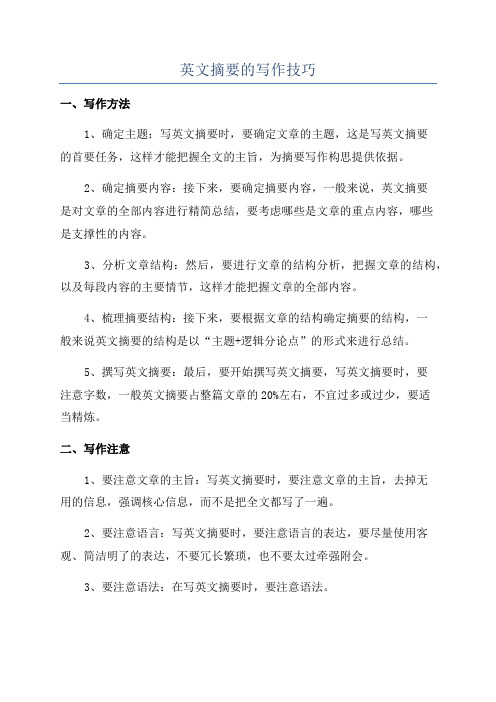
英文摘要的写作技巧
一、写作方法
1、确定主题:写英文摘要时,要确定文章的主题,这是写英文摘要
的首要任务,这样才能把握全文的主旨,为摘要写作构思提供依据。
2、确定摘要内容:接下来,要确定摘要内容,一般来说,英文摘要
是对文章的全部内容进行精简总结,要考虑哪些是文章的重点内容,哪些
是支撑性的内容。
3、分析文章结构:然后,要进行文章的结构分析,把握文章的结构,以及每段内容的主要情节,这样才能把握文章的全部内容。
4、梳理摘要结构:接下来,要根据文章的结构确定摘要的结构,一
般来说英文摘要的结构是以“主题+逻辑分论点”的形式来进行总结。
5、撰写英文摘要:最后,要开始撰写英文摘要,写英文摘要时,要
注意字数,一般英文摘要占整篇文章的20%左右,不宜过多或过少,要适
当精炼。
二、写作注意
1、要注意文章的主旨:写英文摘要时,要注意文章的主旨,去掉无
用的信息,强调核心信息,而不是把全文都写了一遍。
2、要注意语言:写英文摘要时,要注意语言的表达,要尽量使用客观、简洁明了的表达,不要冗长繁琐,也不要太过牵强附会。
3、要注意语法:在写英文摘要时,要注意语法。
学术论文写作格式要求英文摘要常用句型
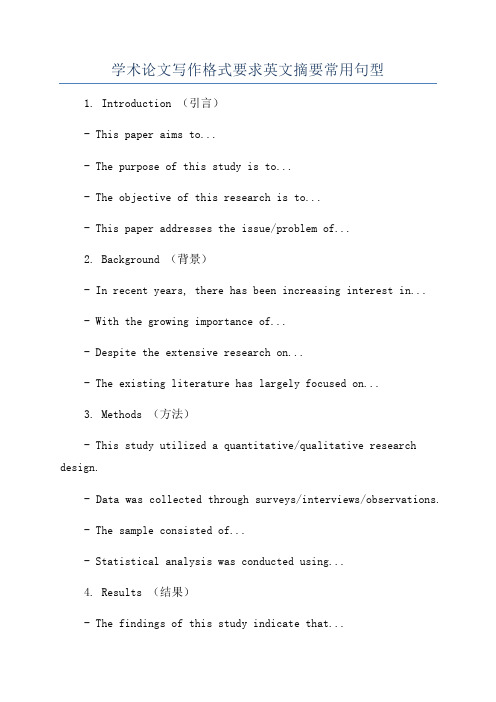
学术论文写作格式要求英文摘要常用句型1. Introduction (引言)- This paper aims to...- The purpose of this study is to...- The objective of this research is to...- This paper addresses the issue/problem of...2. Background (背景)- In recent years, there has been increasing interest in...- With the growing importance of...- Despite the extensive research on...- The existing literature has largely focused on...3. Methods (方法)- This study utilized a quantitative/qualitative research design.- Data was collected through surveys/interviews/observations.- The sample consisted of...- Statistical analysis was conducted using...4. Results (结果)- The findings of this study indicate that...- The results suggest that...- The analysis revealed that...- There is a significant correlation between...5. Discussion (讨论)- These results provide insights into...- The implications of these findings are discussed in terms of...- The present study contributes to the understanding of...- These findings are consistent with previous research in the field of...6. Conclusion (结论)- In conclusion, this study highlights the importance of...- Based on the findings, it can be concluded that...- This study provides valuable information for...- Further research is needed to explore...7. Limitations (限制)- Although this study has provided significant insights, it is not without limitations.- One limitation of this study is the small sample size.- Another limitation is the reliance on self-reported data.- Future research should address these limitations by...8. Implications (意义)- The findings of this study have practical implications for...- These results have important implications for policymakers/practitioners.- The implications of this study extend beyond the specific context of...- This research contributes to the theoretical understanding of...9. Future Directions (未来方向)- Future research should explore...- Further investigation is needed to determine...- Future studies could examine...- This research sets the stage for future research on...。
关于学术论文英文摘要写作技巧
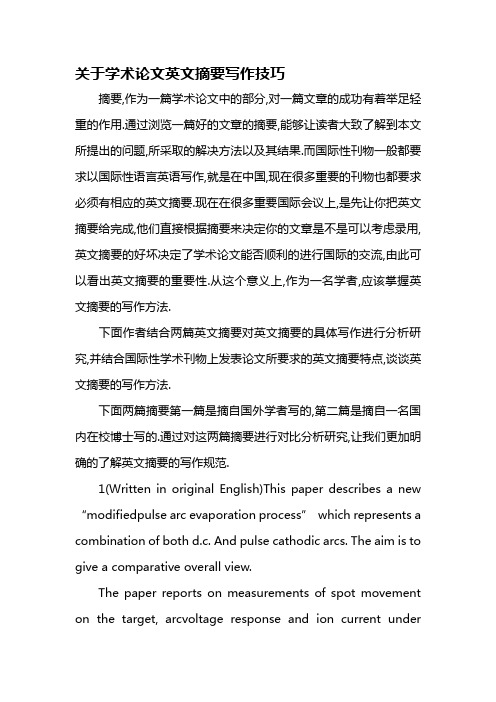
关于学术论文英文摘要写作技巧摘要,作为一篇学术论文中的部分,对一篇文章的成功有着举足轻重的作用.通过浏览一篇好的文章的摘要,能够让读者大致了解到本文所提出的问题,所采取的解决方法以及其结果.而国际性刊物一般都要求以国际性语言英语写作,就是在中国,现在很多重要的刊物也都要求必须有相应的英文摘要.现在在很多重要国际会议上,是先让你把英文摘要给完成,他们直接根据摘要来决定你的文章是不是可以考虑录用,英文摘要的好坏决定了学术论文能否顺利的进行国际的交流,由此可以看出英文摘要的重要性.从这个意义上,作为一名学者,应该掌握英文摘要的写作方法.下面作者结合两篇英文摘要对英文摘要的具体写作进行分析研究,并结合国际性学术刊物上发表论文所要求的英文摘要特点,谈谈英文摘要的写作方法.下面两篇摘要第一篇是摘自国外学者写的,第二篇是摘自一名国内在校博士写的.通过对这两篇摘要进行对比分析研究,让我们更加明确的了解英文摘要的写作规范.1(Written in original English)This paper describes a new “modifiedpulse arc evaporation process”which represents a combination of both d.c. And pulse cathodic arcs. The aim is to give a comparative overall view.The paper reports on measurements of spot movement on the target, arcvoltage response and ion current underdifferent electric conditions, suchas current magnitude, current changing rate and pulse duration. There arepossibilities to improve the target consumption; to reduce the upperstability limit; and to increase the spot velocity, the bias current densityin the pulse phase and the plasma power. For optical measurements ofspot movement a new high-speed video camera was used.2(Written by Chinese student in English) Every machining techniqueleads to distinguishing surface feature and precision characteristic. Thenon -traditional finish machining can improve the surface quality andprecision of parts. The improvement of these can advance the performanceand life of parts. The non-traditional machining has its superiority.英文摘要大体上包括四个部分:研究目的、方法、结果、结论.研究目的主要说明作者写此文章的目的或主要解决的问题,表明研究的范围和重要性;研究的方法主要是提出解决问题的方法以及主要工作过程;研究的结果则是作者在此研究过程最后得到的结果;结论是说明该研究结果的实际应用价值.文章的研究目的必须在英文摘要中体现出来.从摘要1中“Thispaper describes a new ”modified pulse arc evaporation process“whichrepresents a combination of bothd.c. And pulse cathodic arcs. The aim isto give a comparative overall view.”我们可以明显看到该文章的研究目的.鲜明的文章目的能够让读者一目了然的了解到这篇文章所要论述的内容,但是在实际写作中,有很多学者在整篇摘要里面都是一些一般性的论述,说来说去,最后让别人读了一半天,也不知道这篇文章是要解决什么问题.第二篇摘要从前到后都是在陈述光整加工技术,让人很迷惑,不知道这篇文章重点是要论述那一方面的内容.一篇没有目的性的文章自然也就没有可读性.研究的方法也应该在英文摘要中体现出来,这一点是很多中国学者很容易忽视的.从上面两篇摘要对比就可以发现:第一篇中的“measures”就告诉了读者本文作者是要通过什么方法来解决所提出的问题;而在第二篇,不但没有像“measure”,“method”等表达方法的词,而且从根本上忽视了这一点.解决的方法应该是一篇文章的核心,没有作者自己的解决思路的摘要,从某种意义上说,这是一篇很失败的文章摘要,那么这篇文章也不可能是一篇好文章.研究的结果作为摘要中一部分也是不可少的,也是作者所采用的解决方法是否合理的一个重要依据.没有研究的结果,就是你选择的方法再好,也只是在纸上谈兵,侃侃而论,没有自己的立论点.在第一篇中,我们可以从“There are possibilities to improve the target consumption;to reduce the upper stability limit; and to increase the spot velocity, thebias current density in the pulse phase and the plasma power.”中了解到作者可能得到的结果.而在第二篇中,结果不是很明显.研究的结论这一部分往往在研究的结果中体现出来,所以在一部分你可以结合研究的结果做出自己的见解.有时候作者可以根据目前的实验结果为了对以后的进一步工作的开展给出自己的结论.最后,在语言表达上也是很重要的一个方面.很多中国学者自己也清楚,一看人家外国学者写的英文摘要就是感觉很舒畅,而且句式结构多样,上下连接紧凑.但是一旦让自己写文章,就开始感觉自己的写的不地道,语句形式单一,给人一种感觉就是在勉强的中文英文之间互译.从第二篇英文摘要上我们就有这种体会,在摘要中几乎所有的语句采用主、谓、宾中国式英语结构,句式千篇一律,而且语句之间没有任何的连接,互相独立.其实,在英文摘要语言表达中,只要你稍微留心注意许多国外优秀的英文摘要,就可以很好的完成.比如在目的中你可以采用“The purpose of this paper is……”句型;在方法中可以采用“The method used in our study isknow……”;在结论中我们可以采用“In conclusion, we state that……”,这样下来既地道又相互连贯,而且层次分明,何乐而不为?另外还需要注意一些的就是英语语法方面.比如在时态上,英文摘要中习惯于一般现在时,能够突出文章内容的即时性和客观性.但也有时候为了便于说明论题发展背景而用过去时或现在完成时.在人称上,只能用第三人称,不能用第一人、第二人称如我、我们等.还有在标点、大小写、缩写等方面也需要留心注意.从上面对比分析,我们可以看到,只要我们认真领会写作规范,注意英语的语言表达特点,并积累一些常用的典型例句,完成一篇好的英文摘要其实很简单的.学术论文。
英文摘要的写作方法与技巧

英文摘要的写作方法与技巧论文摘要是全文的精华,是对一项科学研究工作的总结,对研究目的、方法和研究结果的概括。
笔者根据自己摘要写作的经验并结合专业英语教学和对学生英文摘要的批改,谈谈写好英文摘要的方法和技巧。
英文摘要的写作包括论文的英文标题、作者及其相关信息、摘要和关键词四个部分,下面分别介绍每个部分的写作方法与技巧。
1 论文标题论文标题是全文内容的缩影。
读者通过标题便能够预测论文的主要内容和作者的意图,从而决定是否阅读全文。
我国期刊要求论文题目一般不超过20个汉字,外文题名一般不超过10个实词[1]。
学术文章的标题主要有三种结构:名词性词组(包括动名词)、介词词组、名词词组+介词词组。
间或也用一个疑问句做标题,但一般不用陈述句或动词词组做标题。
(1)名词性词组名词性词组由名词及其修饰语构成。
名词的修饰语可以是形容词、介词短语,又是也可以是另一个名词。
以下各标题分别由两个名词词组构成。
例如:Global Change and Green House Effect(名词词组+名词词组);Adaptation and Mitigation to the Global Change(名词+名词)。
(2)介词词组介词词组由介词+名词或名词词组构成。
如果整个标题就是一个介词词组的话,一般这个介词是on,意思是对的研究。
例如:On the Ecological Obligation。
(3)名词/名词词组+介词词组这是标题中用得最多的结构。
例如:Global Environment Change and Its Impact on Plants(名词词组+名词词组);Discussion on System Method of Studying Global Environmental Change(名词+介词词组)。
(4)其他形式对于值得争议的问题,偶尔可用疑问句作为论文的标题,以点明整个论文讨论的焦点。
例如:Can Global Change Bring Dramatic Disasters to Humans?2 作者学术论文既可以个人名义署名,也可以集体名义署名。
学术论文英语标题和摘要的撰写方法
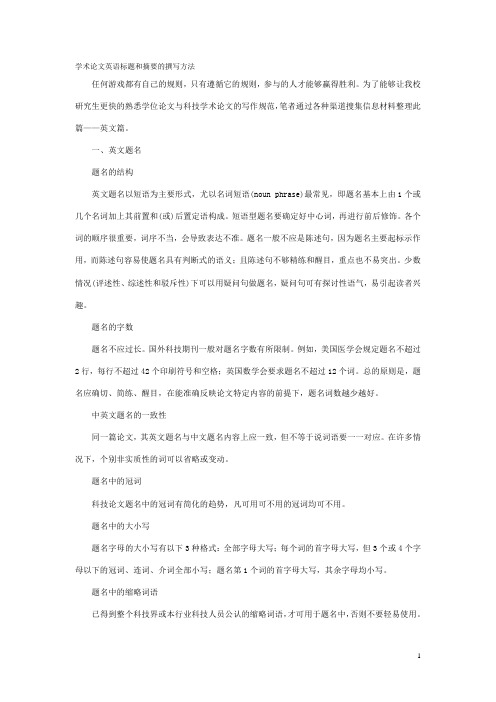
学术论文英语标题和摘要的撰写方法任何游戏都有自己的规则,只有遵循它的规则,参与的人才能够赢得胜利。
为了能够让我校研究生更快的熟悉学位论文与科技学术论文的写作规范,笔者通过各种渠道搜集信息材料整理此篇——英文篇。
一、英文题名题名的结构英文题名以短语为主要形式,尤以名词短语(noun phrase)最常见,即题名基本上由1个或几个名词加上其前置和(或)后置定语构成。
短语型题名要确定好中心词,再进行前后修饰。
各个词的顺序很重要,词序不当,会导致表达不准。
题名一般不应是陈述句,因为题名主要起标示作用,而陈述句容易使题名具有判断式的语义;且陈述句不够精练和醒目,重点也不易突出。
少数情况(评述性、综述性和驳斥性)下可以用疑问句做题名,疑问句可有探讨性语气,易引起读者兴趣。
题名的字数题名不应过长。
国外科技期刊一般对题名字数有所限制。
例如,美国医学会规定题名不超过2行,每行不超过42个印刷符号和空格;英国数学会要求题名不超过12个词。
总的原则是,题名应确切、简练、醒目,在能准确反映论文特定内容的前提下,题名词数越少越好。
中英文题名的一致性同一篇论文,其英文题名与中文题名内容上应一致,但不等于说词语要一一对应。
在许多情况下,个别非实质性的词可以省略或变动。
题名中的冠词科技论文题名中的冠词有简化的趋势,凡可用可不用的冠词均可不用。
题名中的大小写题名字母的大小写有以下3种格式:全部字母大写;每个词的首字母大写,但3个或4个字母以下的冠词、连词、介词全部小写;题名第1个词的首字母大写,其余字母均小写。
题名中的缩略词语已得到整个科技界或本行业科技人员公认的缩略词语,才可用于题名中,否则不要轻易使用。
二、作者与作者单位的英译作者:中国人名按汉语拼音拼写单位:单位名称要写全(由小到大),并附地址和邮政编码,确保联系方便。
三、英文摘要英文摘要的时态:英文摘要时态的运用也以简练为佳。
1、一般现在时:用于说明研究目的、叙述研究内容、描述结果、得出结论、提出建议或讨论等;涉及到公认事实、自然规律、永恒真理等,也要用一般现在时。
英文摘要的写作方法

英文摘要的写作方法论文摘要的时态基本上有两种: 一般现在时、一般过去时。
由于学术论文写作通常采用一般现在时, 摘要也多用一般现在时。
目的、方法、结果及结论部分多用一般现在时, 背景介绍常采用一般过去时。
一般现在时用于描述研究目的和范围、研究内容、结果和结论;一般过去时用于描述论文撰写前作者已做的工作, 也可用于表示转述已发表文献的报导、讨论和研究内容。
语态与人称主张多采用被动语态。
因为使用被动语态不仅可以省略施动者, 避免出现“We”表示式, 而且还可以使需强调的事物做主语而突出了它们的地位, 有利于说明事实。
英文摘要往往采用第三人称的被动语态, 可以避免提及有关执行者, 使行文显得客观。
同时, 被动语态句子在结构上有较大的调节余地, 有利于使用恰当的修辞手段, 扩展名词短语, 扩大句子信息量。
但有时采用主动语态比用被动语态在结构上更简练, 表达更英文摘要的翻译英文摘要应直接用英文写, 这样能按英文思维方式更直接、准确地表达原文。
但是, 这对一些作者尚有难度。
在翻译过程中, 要避免按中文字面意义逐字翻译, 应从语篇层次把握原文, 选择恰当的翻译单位。
刘士聪认为, 在翻译过程中, 分析和转换是一个难以截然分开的思维过程, 以主述位作翻译单位, 一方面是注意到了它本身的形式特点, 另一方面也注意到了它在语篇中的衔接功能, 可以把对原文的分析和转换统一起来。
英文摘要的写作根据《EI》的要求, 一篇较好的英文摘要应较好地回答以下4 个方面的问题:1) What you want to do ( 目的);2) How you did it ( 方法); 3) What results did you get and what conclusions can you draw ( 结果和结论); 4) What is original in your paner ( 创新独到之处) 。
在开头交待论文的目的时, 英文摘要的首句不要重复题名或题名的一部分, 同时摘要中要尽量少谈或不谈背景信息。
英语专业学术论文写作:摘要

英语专业学术论⽂写作:摘要学术论⽂写作:摘要⼀、摘要的写作⽬的和结构要素摘要简要地概述论⽂的内容, 拥有与正⽂同等量的主要信息,即不阅读全⽂,就能获得必要的信息。
其结构要素是:(1) 主题阐述(Topic specification);(2) 研究⽬的陈述(Purpose statement);(3) 理论指导(Theory/Perspective)(3) 研究⽅法(Methodology and Data);(4) 研究结果/发现(Results/Findings);(5) 研究结论/启⽰(Conclusions/Implications)。
练习1:就结构要素评析下⾯4个摘要(为判断⽅便,列汉语标题)Sample 11. Introduction2. Translation Activity in New Century2.1Definition and Purpose of Translation Activity2.2 Translation Activity under the Background of Cross-culture Communication2.2.1The Trend of Cross-culture Communication2.2.2 New Requirements for Translation Activity3. The Trend of Cross-culture Communication3.1 Definitions of Cultural Symbols3.2 The Formation of Characteristic Cultural Symbols3.3Main Categories of Cultural Symbols4. Strategy in Dealing with Cultural Symbols Translation4.1 Comparison between Domestication and Foreignization4.2 Nida Eugene. A and Dynamic Equivalence Translation4.3 Translation Studies School and Foreignization4.4 Two Strategies in Text Analysis5. Conclusion1. Introduction2. The Rhetorical Motivation in Trade Name2.1 Rational Needs and Rational Needs2.1.1 Rational Needs2.1.2 Emotional Needs2.2 Cultural Factors2.2.1 Ethnic Culture2.2.2 Regional Culture2.2.3 Religious Culture2.2.4 Culture of Place and Person3. The Rhetorical Approaches to Trade Name 3.1 Homophone3.1.1 Homophone in Chinese3.1.2 Homophone between Chinese and English 3.1.3 Homophone in English3.2 Onomatopoeia3.2.1 Emotional onomatopoeia3.2.2 Rational onomatopoeia3.3 Rhyme3.3.1 Alliteration3.3.2 The Ending of Lines of Verse3.3.3 Assonance3.4 Reduplicated Sound4. The Translation of Trade Names4.1 Transliteration4.2 Variant Translation4.3 Phonological and Semantic Combination5. Conclusion附:该论⽂⽬录CONTENTS1. Introduction1.1 Rational and Objective of the Study1.2 Organization of the Paper2.Theoretical Foundation of Verbal Irony Study: A Pragmatic Approach2.1 Description of Verbal Irony2.2 Gricean Perspectives—Irony as Conversational Implicature2.3 Post-Gricean perspective—Irony as Echoic Mentioning3. Verbal Irony and the Responses in Public Debate3.1 Assumptions and Expectations3.2 Introduction to American Public Presidential Debate (APPD) and the Debate Extract Analyzed3.3 Analysis Based on EMT4. Conclusion4.1 Findings in EMT Application—Uncertainty4.1.1 Uncertainty in Identifying Verbal Irony4.1.2 Uncertainty in Justifying the Working Mechanism4.2 Tentative Suggestion—Pragmatics with Lights from the Rhetorical Perspective 4.3 Last Remarks附:该论⽂⽬录CONTENTS1. Introduction1.1Rationale1.2 Literature Review1.3 The Organization of the Thesis2. Theoretical F oundations of D omestication and F oreignization2.1 Domestication and Foreignization2.1.1 Definitions of Domestication and Foreignization2.1.2 Functions of Domestication and Foreignization2.1.2.1 Function of Domestication2.1.2.2 Function of Foreignization2.2 Political News2.2.1 Definition of Political News2.2.2 The Stylistic Features of Political News and Translated PoliticalNews3. Domestication and F oreignization in the T ranslation of P olitical N ews3.1 The Uniqueness of Domestication and Foreignizationin the Translation of Political News3.2 Three Factors Influencing the Choice of Domestication and Foreignization3.2.1 The Translator’s Subjective Factors3.2.2 The Reader3.2.3 The Political Ideology3.3 The Balance of Domestication and Foreignization4. Conclusion⼆、内容的注意事项1. 不要写成⽂献综述(?Sample 1), 也不要说⼈所共知的话(? sample 5)2. 以上结构要素要有具体内容,不要空洞练习2:下⽂是从语⽤顺应理论出发对商务信函写作(sample 5)和商标翻译(Sample 6) 进⾏的研究, 请你(1)删掉⽆关的内容,(2)核对结构要素,(3)并判断哪个内容具体。
如何写英语论文摘要

如何写英语论文摘要
在撰写一个英语论文的摘要时,有几个关键要点需要考虑,以确保摘要的质量和信息量。
以下是撰写英语论文摘要的六个步骤。
1.确定摘要的类型:
-描述性摘要:简要概述论文的主要内容和结论。
-说明性摘要:除了提供主要内容和结论外,还解释研究的意义和方法。
-评论性摘要:除了提供主要内容和结论外,还对论文进行评估和批判。
2.单独撰写摘要:
摘要应该是一个独立的部分,不应与论文的其他部分混淆。
即使读者只阅读摘要,也应该能够理解论文的主要内容和结论。
3.按照一定的结构撰写:
摘要应该包括以下几个部分:
-引言:介绍研究的背景和目的。
-方法:简要描述研究所用的方法和研究对象。
-结果:总结研究的主要结果。
-讨论:讨论研究结果的意义和可能的局限性。
-结论:阐述研究的主要结论。
4.保持简洁:
摘要应该尽量精炼、简明扼要地表达论文的主要内容。
避免冗长的插入语和过多的细节。
5.不要引用:
6.仔细校对:
在撰写完摘要后,仔细校对并检查语法、拼写和语句结构。
确保摘要的清晰、准确和流畅。
总之,在撰写英语论文摘要时,应该多花时间思考和规划摘要的结构和内容。
通过提供简明的综述和清晰的结论,摘要应该能够吸引读者并引起他们对论文的兴趣。
学术论文英文摘要写作要点
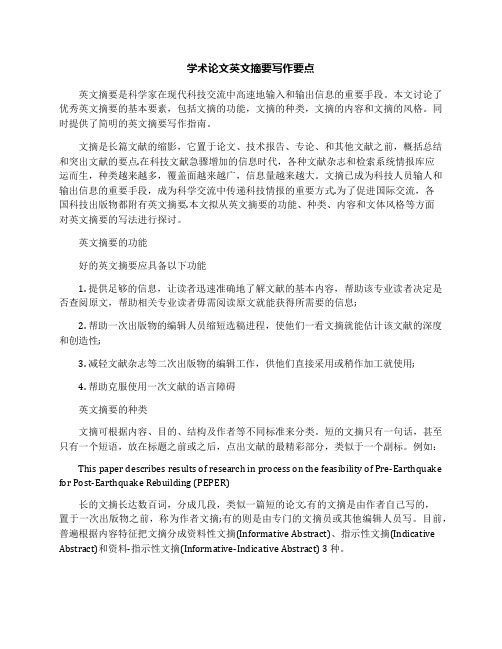
学术论文英文摘要写作要点英文摘要是科学家在现代科技交流中高速地输入和输出信息的重要手段。
本文讨论了优秀英文摘要的基本要素,包括文摘的功能,文摘的种类,文摘的内容和文摘的风格。
同时提供了简明的英文摘要写作指南。
文摘是长篇文献的缩影,它置于论文、技术报告、专论、和其他文献之前,概括总结和突出文献的要点.在科技文献急骤增加的信息时代,各种文献杂志和检索系统情报库应运而生,种类越来越多,覆盖面越来越广,信息量越来越大。
文摘已成为科技人员输人和输出信息的重要手段,成为科学交流中传递科技情报的重要方式.为了促进国际交流,各国科技出版物都附有英文摘要.本文拟从英文摘要的功能、种类、内容和文体风格等方面对英文摘要的写法进行探讨。
英文摘要的功能好的英文摘要应具备以下功能1. 提供足够的信息,让读者迅速准确地了解文献的基本内容,帮助该专业读者决定是否查阅原文,帮助相关专业读者毋需阅读原文就能获得所需要的信息;2. 帮助一次出版物的编辑人员缩短选稿进程,使他们一看文摘就能估计该文献的深度和创造性;3. 减轻文献杂志等二次出版物的编辑工作,供他们直接采用或稍作加工就使用;4. 帮助克服使用一次文献的语言障碍英文摘要的种类文摘可根据内容、目的、结构及作者等不同标准来分类。
短的文摘只有一句话,甚至只有一个短语,放在标题之前或之后,点出文献的最精彩部分,类似于一个副标。
例如:This paper describes results of research in process on the feasibility of Pre-Earthquake for Post-Earthquake Rebuilding (PEPER)长的文摘长达数百词,分成几段,类似一篇短的论文.有的文摘是由作者自己写的,置于一次出版物之前,称为作者文摘;有的则是由专门的文摘员或其他编辑人员写。
目前,普遍根据内容特征把文摘分成资料性文摘(Informative Abstract)、指示性文摘(Indicative Abstract)和资料-指示性文摘(Informative-Indicative Abstract) 3 种。
英文摘要的书写技巧

英文摘要的书写技巧英文摘要通常是学术论文、科技报告、研究成果等的第一篇引言,短小精悍地概括了文章的主要内容和意义。
因此,良好的英文摘要是保证文章成功的基础之一。
下面我们来谈一谈英文摘要的书写技巧。
一、准确翻译思路英文摘要通常是中文原文的直接翻译,因此必须先确保中文原文表达的思路、结构、内容的翻译准确无误。
翻译在整个英文摘要中扮演着至关重要的角色。
精准的翻译可以使读者更好地理解文章,突显作者的研究价值。
二、简明扼要地表达研究目的和主题在英文摘要中,作者必须简明扼要地表达文章的主题和研究目的。
语言应当简练,措辞准确明确,尽量避免使用模糊、罗嗦的词汇。
在表述研究目的的同时,需要说明该研究为何具有重要性和应用前景,这有助于提高读者的兴趣和关注度。
三、突出研究方法和成果英文摘要应当突出研究方法和成果,作者应当简明扼要地说明采用的研究方法和技术,以及所得到的主要研究成果。
在突出研究方法的同时,必须确保语言简练,避免使用过多的专业术语和公式,增强阅读体验。
四、突出文章的创新点和贡献英文摘要中应当突出文章的创新点和贡献。
作者应当清晰阐述论文的独特性、创新性,突出自己的贡献和价值。
这些创新点和贡献是吸引读者和其他研究者对文章进行深入研究的重要因素。
五、注意英文语法和表达方式英文摘要是文章的门面,因此要注意英文语法和表达方式。
在撰写英文摘要的时候,应当尽量使用简单明了的语言,突出文章主旨,并注意英文语法中的时态、语态和词性等问题。
特别是在使用专业术语的时候,要确保使用正确,并注意缩写表述的准确性和标点符号的正确使用。
六、注意逻辑和流畅度英文摘要在语言、结构和内容方面都需要严密把握,从而使整篇文章的逻辑性更加强大准确,流畅度更加突出。
要注意写作结构的组合,通过适当的段落进行分隔和连接,让阅读者更好地理解文章脉络。
此外,要注重内容的全面性和准确性,从而使研究更具说服力和参考性。
综上所述,英文摘要的书写技巧涉及到语言的准确性、表达方式的简洁清晰性、逻辑性和流畅度。
学术论文英文摘要如何撰写

学术论文英文摘要如何撰写Writing an Academic Paper AbstractWriting an abstract for an academic paper is an essential task that helps summarize the content of the paper in a succinct and informative way. An abstract is typically written in English and is asked for by many journals, conferences, and academic institutions. It is usually limited to a specific word count, often around 1200 words or less. Here, we will explore the key elements and tips for writing an effective abstract.1. Background and Purpose: Begin the abstract by providing a brief introduction to the topic, explaining its significance, and stating the purpose or objective of the study. This background information should give readers an understanding of the context of the research.2. Methods: Describe the methods or approach used to conduct the study. This section should include relevant details such as the research design, participants or sample size, datacollection methods, and any statistical analyses used. Provide enough information for readers to understand how the study was conducted.4. Conclusion: Present a concise summary of the major conclusions drawn from the study. Explain how the findings contribute to or impact the existing knowledge within the field.Highlight the significance of the study and its implications for future research or practical applications.5. Keywords: Include a list of relevant keywords at the end of the abstract. Keywords provide a way for readers to easily find your paper when searching for related topics or content. Choose keywords that accurately reflect the focus and subject matter of the study.Tips for Writing an Effective Abstract:1. Be concise: Use clear and concise language to convey the purpose, methodology, results, and conclusions of the study. Avoid unnecessary details or jargon that may confuse readers.2. Use active voice: Write in an active voice to make the abstract engaging and direct. This helps in clearly stating the main findings and conclusions.4. Follow the guidelines: Make sure to adhere to thespecific guidelines provided by the journal or conference for abstract length, formatting, and structure. Failure to follow these guidelines may result in an abstract being rejected.6. Seek feedback: Have someone familiar with the topic or the field review and provide feedback on the abstract. They can help ensure that the abstract is accessible and understandable to a broader audience.。
英文摘要的写作技巧

英文摘要的写作技巧英文摘要的写作技巧导语:英文摘要(Abstract)的写作应用很广。
论文摘要是全文的精华,是对一项科学研究工作的总结,对研究目的、方法和研究结果的概括。
以下是小编为大家精心整理的英文摘要的写作技巧,欢迎大家阅读参考!一、摘要的种类与特点摘要主要有以下四种。
第一种是随同论文一起在学术刊物上发表的摘要。
这种摘要置于主体部分之前,目的是让读者首先了解一下论文的内容,以便决定是否阅读全文。
一般来说,这种摘要在全文完成之后写。
字数限制在100~150字之间。
内容包括研究目的、研究方法、研究结果和主要结论。
第二种是学术会议论文摘要。
会议论文摘要往往在会议召开之前几个月撰写,目的是交给会议论文评审委员会评阅,从而决定是否能够录用。
所以,比第一种略为详细,长度在200—300字之间。
会议论文摘要的开头有必要简单介绍一下研究课题的意义、目的、宗旨等。
如果在写摘要时,研究工作尚未完成,全部研究结果还未得到,那么,应在方法、目的、宗旨、假设等方面多花笔墨。
第三种为学位论文摘要。
学士、硕士和博士论文摘要一般都要求用中、英文两种语言写。
学位论文摘要一般在400字左右,根据需要可以分为几个段落。
内容一般包括研究背景、意义、主旨和目的;基本理论依据,基本假设;研究方法;研究结果;主要创新点;简短讨论。
不同级别的学位论文摘要,要突出不同程度的创新之处,指出有何新的观点、见解或解决问题的新方法。
第四种是脱离原文而独立发表的摘要。
这种摘要更应该具有独立性、自含性、完整性。
读者无需阅读全文,便可以了解全文的主要内容。
二、摘要的内容与结构摘要内容一般包括:Ø 目的(objectives,purposes):包括研究背景、范围、内容、要解决的问题及解决这一问题的重要性和意义。
Ø 方法(methods and materials):包括材料、手段和过程。
Ø 结果与简短讨论(results and discussions):包括数据与分析。
学术论文英文摘要的写作方法
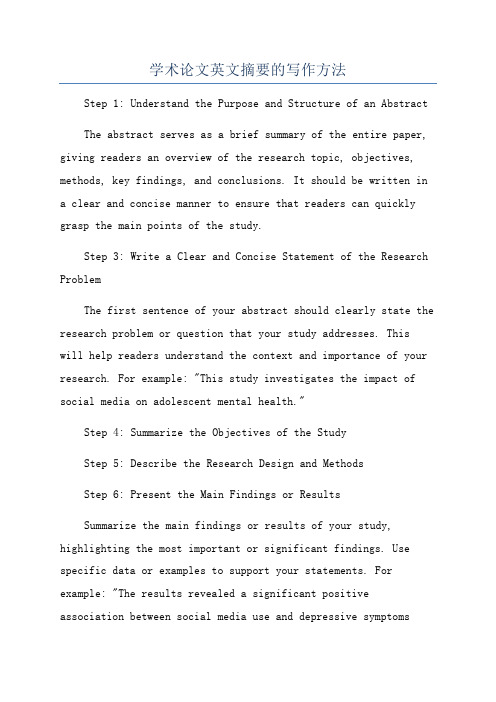
学术论文英文摘要的写作方法Step 1: Understand the Purpose and Structure of an Abstract The abstract serves as a brief summary of the entire paper, giving readers an overview of the research topic, objectives, methods, key findings, and conclusions. It should be written in a clear and concise manner to ensure that readers can quickly grasp the main points of the study.Step 3: Write a Clear and Concise Statement of the Research ProblemThe first sentence of your abstract should clearly state the research problem or question that your study addresses. Thiswill help readers understand the context and importance of your research. For example: "This study investigates the impact of social media on adolescent mental health."Step 4: Summarize the Objectives of the StudyStep 5: Describe the Research Design and MethodsStep 6: Present the Main Findings or ResultsSummarize the main findings or results of your study, highlighting the most important or significant findings. Use specific data or examples to support your statements. For example: "The results revealed a significant positive association between social media use and depressive symptomsamong adolescents. Furthermore, self-esteem was found to mediate this relationship, while age and gender were found to moderate the association."Step 7: Discuss the Implications or Significance of the StudyIn the final sentences of your abstract, discuss the implications or significance of your study. Explain how your findings contribute to the existing literature, highlight any practical implications, and suggest potential areas for future research. For example: "These findings have important implications for the understanding and prevention of adolescent mental health problems. Interventions targeting social media use and self-esteem may be effective in reducing depressive symptoms among this population. Further research is needed to explore the long-term effects and mechanisms underlying this relationship."Step 8: Revise and Edit the AbstractAfter writing the abstract, revise and edit it to ensure clarity, coherence, and conciseness. Remove any unnecessary details, jargon, or technical terms that may make it difficult for non-experts to understand. Make sure that the abstract flows logically and provides a clear summary of the research.Tips for Writing an Effective Abstract:1. Use concise and specific language: Every word counts in an abstract, so choose your words carefully and aim for clear, specific, and concise language.2. Focus on the most important findings: Highlight the key findings that are most relevant to your research question and objectives.3. Avoid unnecessary details: Only include essential information in your abstract. Avoid going into excessive detail or providing background information that is not directly related to your research.4. Be accurate and truthful: Ensure that the information provided in your abstract is accurate and supported by evidence from your study.5. Follow the guidelines provided by the journal or conference: Different journals or conferences may have specific requirements for abstracts, so make sure to follow their guidelines.Example of an Abstract:Title: The Impact of Social Media on Adolescent Mental Health: A Cross-Sectional StudyAbstract:。
英文摘要书写技巧

英文摘要书写技巧Abstract Writing Tips (1500 words)Writing an abstract is a crucial skill for researchers and academics as it helps them communicate the essence of their work in a concise and accessible manner. An abstract is a summary of a research paper, report, or article that provides an overview of the main points and findings. This article provides some useful tips for writing effective and compelling abstracts.1. Understand the Purpose of an Abstract: Before starting to write the abstract, it is important to understand its purpose. An abstract serves as a snapshot of the entire work and allows readers to quickly determine if the study is relevant to their interests. It should provide enough information to help readers decide whether to read the full paper or not.2. Follow the Structure: Abstracts generally follow a specific structure that includes the background, objective, methods, results, and conclusions of the study. However, this structure may vary depending on the requirements of the journal or conference you are submitting to. It is essential to follow the prescribed structure to ensure that all the necessary information is included.3. Be Concise: Abstracts should be concise and to the point. Since they have word limits, it is important to prioritize the most essential information and avoid unnecessary details. A good abstract should be between 150-250 words, depending on the guidelines provided by the target journal or conference.4. Use Clear and Straightforward Language: Abstracts should be written using clear and straightforward language. Avoid unnecessary jargon or technical terms that may confuse the readers. Instead, use terminology that is easily understandable to a broad audience. Remember that the purpose of an abstract is to present your work to a wider audience, including non-specialists.5. Highlight Key Points: Since abstracts serve as a summary, it is important to highlight the key points of your work. These are usually the main objectives, methods, major findings, and significant conclusions. By emphasizing these key elements, readers can get a clear idea of your research without going through the entire paper.6. Be Accurate and Objective: When writing an abstract, it is crucial to be accurate and objective. Avoid making exaggerated claims or overgeneralizations about your findings. Stick to the facts and provide a fair representation of your research. This will help establish credibility and trust among the readers.7. Avoid Citations and References: Abstracts should not include citations or references to other papers or sources. It is not the place to provide a detailed literature review. Instead, focus on summarizing your own work without external references.8. Proofread and Edit: Like any other piece of writing, abstracts should be proofread and edited to ensure clarity and correctness. Pay attention to grammar, spelling, and punctuation errors. Ensure that the abstract reads smoothly and provides a coherent summary of your study.9. Revise for Different Platforms: If you plan to submit your work to multiple journals or conferences, it is important to revise your abstract accordingly. Each target platform may have different requirements, such as word limits or specific sections to include. Tailor your abstract to meet these requirements, ensuring that it optimally represents your research for each platform.10. Seek feedback: Lastly, it is always beneficial to seek feedback from colleagues, mentors, or writing professionals. They can provide valuable insights and suggestions for improving your abstract. Incorporate their feedback to enhance the quality and impact of your abstract.In conclusion, writing an abstract requires careful consideration and attention to detail. By following these tips, you can effectively summarize your research and engage readers, ultimately increasing the visibility and impact of your work.11. Customize for Different Disciplines: It is important to keep in mind that abstracts may vary across different disciplines. Depending on the field of study, different aspects may be prioritized. For example, in scientific research, the methods and results sections may be more emphasized, while in humanities research, the theoretical framework and analysis may be more prominent. Therefore, it is crucial to tailor your abstract to the specific requirements and conventions of your discipline.12. State the Problem or Research Question: Start your abstract by clearly stating the problem or research question your study addresses. This helps readers understand the purpose and relevanceof your work. Be brief but specific in describing the issue you are investigating.13. Provide Context: In addition to stating the problem, it is important to provide some context for your study. This can include a brief background or literature review to explain the significance of the research. However, be cautious not to make the abstract too lengthy or to include excessive details. Focus on the key aspects that are directly relevant to your study.14. Summarize the Methodology: Briefly describe the methodology or approach used in your study. This includes the research design, data collection methods, and any analytical techniques employed. Highlight the key steps or procedures that are crucial for understanding your findings.15. Summarize the Results: Outline the main findings or results of your study. Be concise and specific, avoiding ambiguous or vague statements. If possible, use quantitative or qualitative data to support your conclusions. It is important to convey the most significant findings in a clear and understandable manner.16. Emphasize Novelty or Contribution: If your study has a unique or innovative aspect, make sure to highlight it in the abstract. This could be a novel methodology, a new theoretical framework, or a significant contribution to the existing literature. By emphasizing the novelty of your work, you can attract the attention of readers and make your abstract stand out.17. State the Implications and Conclusions: Conclude your abstractby summarizing the implications and conclusions of your study. Explain how your findings contribute to the existing knowledge, theory, or practice in your field. If applicable, mention any limitations or caveats of your study. By providing a clear and realistic assessment of your work, you can demonstrate its importance and practical implications.18. Include Keywords: Many journals and conferences require authors to include a list of keywords in their abstracts. Keywords are specific terms or phrases that represent the main topics or themes of your research. They help search engines and researchers find your work more easily. Choose keywords that accurately reflect the content and scope of your study.19. Pay Attention to Formatting and Style: When writing an abstract, it is important to adhere to the specific formatting and style guidelines of your target journal or conference. This includes font size, word limits, and citation styles, among others. Ensure that your abstract is properly formatted and meets all the requirements to avoid potential rejection or issues during the submission process.20. Keep Revising and Improving: Abstract writing is an iterative process. It is rare to have a perfect abstract in the first draft. Continuously revise and refine your abstract to make it more compelling and impactful. Seek feedback from colleagues, mentors, or experts in your field. Incorporate their suggestions and polish your abstract to enhance its quality and effectiveness.Writing an abstract is a skill that improves with practice. Byfollowing these tips and continually honing your abstract writing abilities, you can effectively communicate the essence of your research and increase its visibility and impact in your field. Keep in mind that abstracts play a crucial role in attracting readers' attention, so invest time and effort into crafting a clear, concise, and engaging abstract that accurately represents your work.。
- 1、下载文档前请自行甄别文档内容的完整性,平台不提供额外的编辑、内容补充、找答案等附加服务。
- 2、"仅部分预览"的文档,不可在线预览部分如存在完整性等问题,可反馈申请退款(可完整预览的文档不适用该条件!)。
- 3、如文档侵犯您的权益,请联系客服反馈,我们会尽快为您处理(人工客服工作时间:9:00-18:30)。
关于学术论文英文摘要写作技巧
下面是关于学术论文英文摘要写作技巧,欢迎阅读借鉴,希望对你们有帮助。
摘要,作为一篇学术论文中的部分,对一篇文章的成功有着举足轻重的作用.通过浏览一篇好的文章的摘要,能够让读者大致了解到本文所提出的问题,所采取的解决方法以及其结果.而国际性刊物一般都要求以国际性语言英语写作,就是在中国,现在很多重要的刊物也都要求必须有相应的英文摘要.现在在很多重要国际会议上,是先让你把英文摘要给完成,他们直接根据摘要来决定你的文章是不是可以考虑录用,英文摘要的好坏决定了学术论文能否顺利的进行国际的交流,由此可以看出英文摘要的重要性.从这个意义上,作为一名学者,应该掌握英文摘要的写作方法.
下面作者结合两篇英文摘要对英文摘要的具体写作进行分析研究,并结合国际性学术刊物上发表论文所要求的英文摘要特点,谈谈英文摘要的写作方法.
下面两篇摘要第一篇是摘自国外学者写的,第二篇是摘自一名国内在校博士写的.通过对这两篇摘要进行对比分析研究,让我们更加明确的了解英文摘要的写作规范.
1(Written in original English)This paper describes a new “modifiedpulse arc evaporation process”which represents a combination of both d.c. And pulse cathodic arcs. The aim is to
give a comparative overall view.
The paper reports on measurements of spot movement on the target, arcvoltage response and ion current under different electric conditions, suchas current magnitude, current changing rate and pulse duration. There arepossibilities to improve the target consumption; to reduce the upperstability limit; and to increase the spot velocity, the bias current densityin the pulse phase and the plasma power. For optical measurements ofspot movement a new high-speed video camera was used.
2(Written by Chinese student in English) Every machining techniqueleads to distinguishing surface feature and precision characteristic. Thenon -traditional finish machining can improve the surface quality andprecision of parts. The improvement of these can advance the performanceand life of parts. The non-traditional machining has its superiority.
英文摘要大体上包括四个部分:
研究目的、方法、结果、结论.
研究目的主要说明作者写此文章的目的或主要解决的问题,表明研究的范围和重要性;研究的方法主要是提出解决问题的方法以及主要工作过程;研究的结果则是作者在此研究过程最后得到的结果;结论是说明该研究结果的实际应用价值.
文章的研究目的必须在英文摘要中体现出来.
从摘要1中“Thispaper describes a new ”modified pulse arc evaporation process“whichrepresents a combination of both d.c. And pulse cathodic arcs. The aim isto give a comparative overall view.”
我们可以明显看到该文章的研究目的.
鲜明的文章目的能够让读者一目了然的了解到这篇文章所要论述的内容,但是在实际写作中,有很多学者在整篇摘要里面都是一些一般性的论述,说来说去,最后让别人读了一半天,也不知道这篇文章是要解决什么问题.
第二篇摘要从前到后都是在陈述光整加工技术,让人很迷惑,不知道这篇文章重点是要论述那一方面的内容.
一篇没有目的性的文章自然也就没有可读性.
研究的方法也应该在英文摘要中体现出来,这一点是很多中国学者很容易忽视的.
从上面两篇摘要对比就可以发现:
第一篇中的“measures”就告诉了读者本文作者是要通过什么方法来解决所提出的问题;而在第二篇,不但没有像“measure”,“method”等表达方法的词,而且从根本上忽视了这一点.
解决的方法应该是一篇文章的核心,没有作者自己的解决思路的摘要,从某种意义上说,这是一篇很失败的文章摘要,那么这篇文章也不可能是一篇好文章.
研究的结果作为摘要中一部分也是不可少的,也是作者所采用的解决方法是否合理的一个重要依据.
没有研究的结果,就是你选择的方法再好,也只是在纸上谈兵,侃侃而论,没有自己的立论点.
在第一篇中,我们可以从“There are possibilities to improve the target consumption;to reduce the upper stability limit; and to increase the spot velocity, thebias current density in the pulse phase and the plasma power.”中了解到作者可能得到的结果.
而在第二篇中,结果不是很明显.
研究的结论这一部分往往在研究的结果中体现出来,所以在一部分你可以结合研究的结果做出自己的见解.有时候作者可以根据目前的实验结果为了对以后的进一步工作的开展给出自己的结论.
最后,在语言表达上也是很重要的一个方面.很多中国学者自己也清楚,一看人家外国学者写的英文摘要就是感觉很舒畅,而且句式结构多样,上下连接紧凑.但是一旦让自己写文章,就开始感觉自己的写的不地道,语句形式单一,给人一种感觉就是在勉强的中文英文之间互译.
从第二篇英文摘要上我们就有这种体会,在摘要中几乎所有的语句采用主、谓、宾中国式英语结构,句式千篇一律,而且语句之间没有任何的连接,互相独立.
其实,在英文摘要语言表达中,只要你稍微留心注意许多国外优秀
的英文摘要,就可以很好的完成.
比如在目的中你可以采用“The purpose of this paper is…… ”句型;在方法中可以采用“The method used in our study is know…… ”;在结论中我们可以采用“In conclusion, we state that……”,这样下来既地道又相互连贯,而且层次分明,何乐而不为?
另外还需要注意一些的就是英语语法方面.比如在时态上,英文摘要中习惯于一般现在时,能够突出文章内容的即时性和客观性.但也有时候为了便于说明论题发展背景而用过去时或现在完成时.在人称上,只能用第三人称,不能用第一人、第二人称如我、我们等.
还有在标点、大小写、缩写等方面也需要留心注意.
从上面对比分析,我们可以看到,只要我们认真领会写作规范,注意英语的语言表达特点,并积累一些常用的典型例句,完成一篇好的英文摘要其实很简单的.
学术论文。
